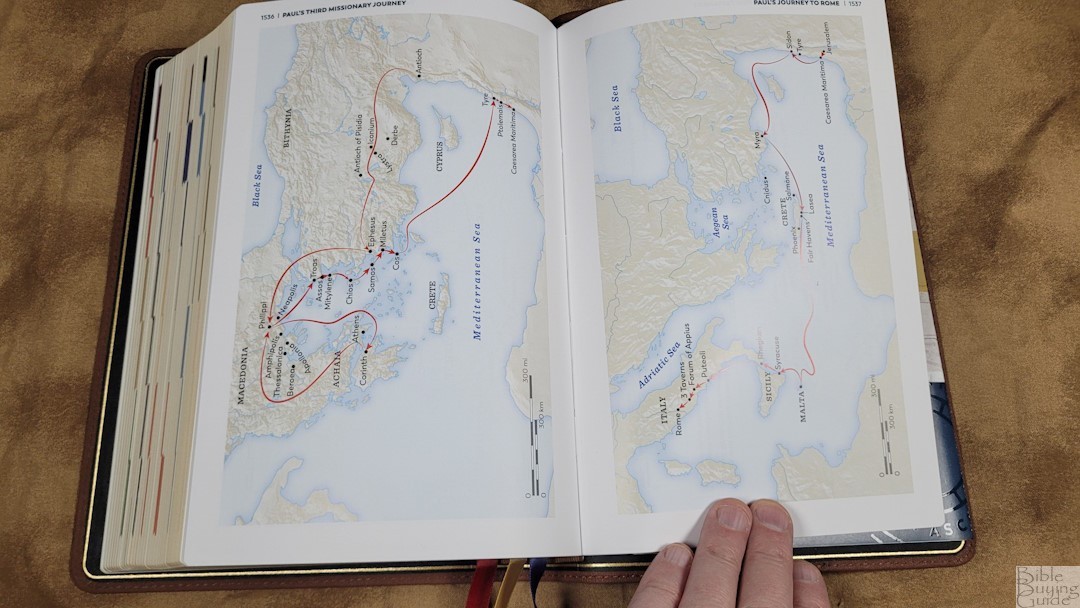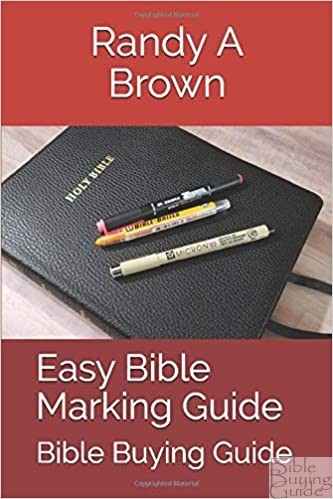
The Great Adventure Catholic Bible second edition in the Revised Standard Version includes the color-coded Bible Timeline Learning System to help make reading and learning easier. It presents the RSV with Apocrypha in a way that looks great and is easy to use. This edition was designed to work with the Catechism of the Catholic Church Ascension Edition, which they also sent me for this review. It’s available in several covers. The second edition was typeset by 2K/Denmark. I’m reviewing the premium edition in brown goatskin, ISBN 9781954882751, printed in China.
Ascension provided this Bible in exchange for an honest review.
_________________________________________________________
This Bible is available at Ascention Press
_________________________________________________________
Table of Contents
- Cover and Binding
- Paper
- Typography
- References
- Book Introductions
- Study Material
- Maps
- The Bible Timeline Chart
- Catechism of the Catholic Church Ascension Edition
- Video Review
- Conclusion
Cover and Binding



The cover is brown goatskin. It has a pebbly grain with the Great Adventure seal stamped into the right corner and Holy Bible printed in gold. It has perimeter stitching. The spine includes 5 raised hubs with text and logos printed in gold. The cover feels a touch stiff, which lets it stay flat in the hand.

The liner is black calfskin and includes a gold decorative line. This is an edge-lined edition and includes a sewn block with overcast stitching. It includes three ribbons in red, yellow, and blue. The overall size is 6.75 x 9.75 x 1.75 inches and weighs 2 lbs, 14.5 oz.
Paper





The paper is 40GSM. It’s cream, which gives it a slightly warm tone with no glare under direct light. The cream color is mostly noticeable in the inner margin where the pages come together. Show-through is minimal. It’s smooth, but I still find it easy to grab and turn. I find this paper great for reading. There are 8 pages in the back for notes.
Typography

The RSV text is presented in a double-column paragraph layout. It doesn’t set lists, letters, or OT quotes apart. The header shows the page number in the outer margin with the book name and chapter number. The inner margin shows the timeline information. The footer includes references, translation footnotes, and other notes. The edge of the pages shows the book name with a color code so you can easily know the types of books you’re turning to by looking at the page edges.

The typeface is around 10 point. This is a red-letter edition. The red letter is dark and easy to read. It has around 10 words per line. It was printed with line-matching to reduce show-through. Psalms include the standard and Hebrew numbering from 11-147 as found in the RSV. The alternative numbering is placed within brackets. They explain this in the introduction notes for Psalms. The poetic text often presents a single word on a line where poetry wraps to the next line.



I found verse numbers easy enough to find. Verse numbers at the beginning of paragraphs are larger and bolder. The text has a lot of white space, making it great for reading and marking. An asterisk in the text shows there is a note at the bottom of the page. Passages in the Apocrypha that don’t appear in all manuscripts are placed within boxes.
References

The references are minimal. They’re placed under the text above the notes. They often cover a range of verses. Here are some example references to help you compare:
- Genesis 1:1 – Jn 1:1
- Deuteronomy 6:4,5 – Mt 22:37; Mk 12:29, 30; Lk 10:27
- Isaiah 9:6 – x
- Matthew 17:20 – Lk 17:6; Mt 21:21; Mk 11:22-23; 1 Cor 13:2; Mk 9:23
- Mark 12:29 – Dt 6:4
- John 1:1 – Gen 1:1; 1 Jn 1:1; Rev 19:13; Jn 17:5
- John 3:16 – Rom 5:8; 8:32; Eph 2:4; 1 Jn 4:9-10
- Acts 2:38 – x
- Romans 10:9 – Mt 10:32; Lk 12:8; Acts 16:31
- 1 John 1:1-2 – Lk 24:39; Jn 1:1, 4; 4:14; 15:27; 20:20, 25; Acts 4:20; 1 Jn 2:13
Book Introductions

The book introductions appear as notes under the text on the first page of each book. They provide a short overview of the book. Most are a paragraph or two.
Study Material
Study material follows the Catholic tradition and uses the Bible Timeline Learning system with color-coded tools. Most of the study material gets out of the way of the text, making this Bible easy to use with or without the material. Just like all study material, I recommend using it for reference and doing your own study.
Color Code

The color code references the Bible Timeline system. It highlights 12 periods of history to show various covenants as shown on the timeline.
Notes

There aren’t a lot of notes, but this Bible does have a few. They are a very small part of this Bible, so I wouldn’t consider this a commentary Bible. If commentary is your goal, this one isn’t what you’re looking for. They’re short and mostly explain something about the text. Some cover a single verse while others cover a larger passage. They usually cover an event, personal, place, or a simple explanation.
Catechism References

Under the cross-references are references to the Catechism of the Catholic Church. They’re color-coded to match the Foundations of Faith approach to show how the Scriptures and teachings connect. They provide a Scripture reference and a colored number. Ascension also sent me the Catechism of the Catholic Church Ascension Edition to see how they work together. I’ll post photos at the end of this review.
Articles

Articles are placed within the text and include charts. They cover the overall story and covenants.
Callouts

Callouts show the key events in history. The text and callouts are marked with a map marker. The callout provides some information about the event, the key passages relating to the event, and supporting verses.
Charts

Charts are detailed and cover characters, key events, maps, and the historical context. They look great and provide nice visuals.
Index of Articles, Charts, Maps, and Key Events

In the front, you’ll find the Index of Articles, Charts, Maps, and Key Events. It breaks everything into sections so everything is easy to find.
Reading Plans

There are several yearly reading plans in the front. The first is The Bible Timeline Reading Plan. It’s divided by month and includes a reading for each day with a box to check that you’ve completed the reading. This one takes you through Acts. The readings are labeled according to the timeline.

Next is the 365-day reading plan for The Bible in a Year with Mike Schmitz and Jeff Cavins. This gives you three readings per day for most days and includes labels for the timeline and checkboxes.
Maps




In the back are 16 maps printed on thick, non-glossy paper. They have muted colors and include some topography. The maps are easy to read, so there’s no index needed. They mostly show locations, routes, and distances.
Maps include:
- The Journeys of Abraham
- The Exodus and Desert Wanderings
- The Tribal Allotments of Israel
- The United Kingdom Under Solomon
- The Divided Kingdom
- The Assyrian Babylonian Empires
- The Persian Empire
- The Greek Empire
- The Roman Empire
- Palestine in the Time of Jesus
- Jerusalem in the Time of Jesus
- Paul’s First Missionary Journey
- Paul’s Second Missionary Journey
- Paul’s Third Missionary Journey
- Paul’s Journey to Rome
- Important Cities of the New Testament
The Bible Timeline Chart




The Bible Timeline Chart is inserted in the back cover. This is a separate pamphlet that works with this Bible. It provides an overview of salvation history, showing how the books of the Bible fit together within that history. The timeline is color-coded with 12 time periods. This is the timeline that The Great Adventure Bible follows. This is a well-designed chart that looks great and is easy to follow.
Catechism of the Catholic Church Ascension Edition
Ascension also sent me their edition of the Catechism of the Catholic Church so I can see how the two work together. It also comes with a separate chart. Here are some photos of this edition.










Video Review
Conclusion
The Great Adventure Catholic Bible is an interesting RSV. It’s well-made and I find it great for reading. Even if you’re not Catholic, this is a good choice if you’re looking for an RSV with Apocrypha.
_________________________________________________________
This Bible is available at Ascention Press
_________________________________________________________
Ascension provided this Bible in exchange for an honest review. I was not required to give a positive review, only an honest one. All opinions are my own.










I’ve debated getting a Catholic Bible just to see how the historic RCC thinks versus the historic Protestant Church. I’ll admit that this is tempting, but, I’d love to see the Douay Rheims given the premium goatskin, edgelined leather treatment. I’d definitely buy one of those. Why do you suppose that Catholic Bibles in English today seem to just be tweaked with Protestant versions? For example, the RSV Catholic Edition.
I was going to purchase this bible until I saw it is printed in CHINA. I WILL NOT BUY A CATHOLIC BIBLE PRINTED IN CHINA. I am upset because it looked great to use for learning deeper and a better way of learning re-learning and fortifying my knowledge. Sorry. But will NOT buy due to Printing in CHINA. SO SAD YOU HAVE TO DO THIS.